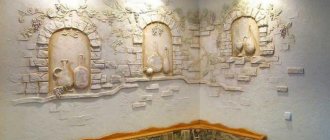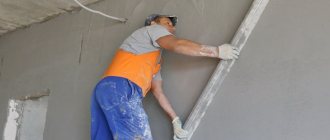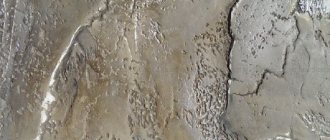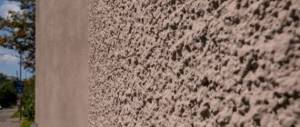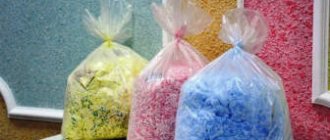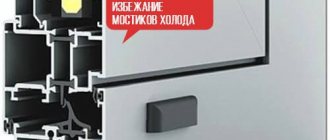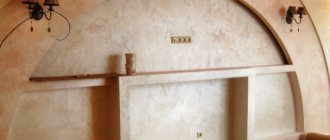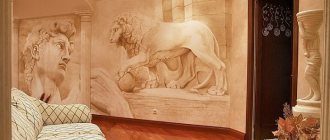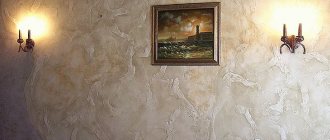Description
“Bark beetle” is a textured decorative plaster with grooves on the surface formed by mineral granules in the mixture. Usually the grooves are created in any direction, and they resemble the passages of a bark beetle in a tree. If the texture has a vertical direction, then the “rain” effect is obtained.
This decorative material is used for finishing building facades, plinths, landings, balconies, corridors and halls in public places where the operational load on the plaster is high. In the interior decoration of residential premises, bark beetle is also used, but less often than other types of textured plaster due to the simplicity of the design.
Kinds
Depending on the binder base, bark beetle plaster can be:
- Cement (mineral). Sold dry in 25 kg bags. Popular brands: Ceresit (Ceresit CT35), Knauf (Knauf Diamant), Bergauf (Bergauf Dekor), Perfekta, etc.
- Silicone (and silicate-silicone) . This is a ready-to-apply white mixture in a 25 kg bucket. The plaster can be tinted directly in the container. Examples of manufacturers: Ceresit ct 75, Farbe Silicon Kratzputz, Baumit, Alpina Silikon.
- Acrylic. The properties are similar to silicone and are also sold in plastic buckets. Brands: Farbe Acryl Reibeputz, Dufa Reibeputz, Raduga-34, Optimist Elite D710 a, etc.
Advantages and disadvantages
Advantages of this decorative plaster:
- Easy to apply. No knowledge of complex techniques is required; anyone can do it.
- Durability and wear resistance. Suitable for finishing external walls, not afraid of moisture, resistant to temperature changes.
- Elasticity of silicone and acrylic coatings.
- Low price. This applies to mineral plasters. Cement dry mixes are much cheaper than polymer ones.
- Looks good in any color. Acrylic and silicone mixtures can be painted in bulk with any available color.
Finishing the staircase
The disadvantages of the “bark beetle” include:
- Simple texture and one-color design. There are more beautiful options for finishing the inside of the house.
- Cement compositions require additional coloring. After drying, they are coated with water-dispersion paint (acrylic, silicone, etc.).
- Cracks are possible if you use a mineral type of plaster mortar.
- Depressions in the texture of the plaster accumulate dust over time, so after a few years the color fades a little.
Specifications
- The main characteristic of the “bark beetle” is grain size , i.e. the size of marble granules that form grooves in plaster. It can be 1 mm, 1.5 mm, 2 mm, 2.5 mm, 3 mm, 3.5 mm.
Important! Decorative plaster is applied in one layer, the thickness of which is equal to the grain size. Therefore, the larger the granules in the composition, the deeper the bark beetle grooves will be, and the higher the material consumption.
- Material consumption varies from 2.5 to 3.5 per 1 m2.
- Water consumption per 1 kg of mixture is 0.2 - 0.25 l.
- The pot life of cement-based mortar is 60 minutes.
- Application temperature +5 +30 °C.
- Frost resistance - F50 - F100.
- Vapor permeability - 0.1 mg/m•h•Pa
- Substrate for application: brick, concrete, cellular concrete blocks, cement and gypsum plaster, putty, OSB boards, plasterboard.
- Service life from 5 years - cement-based, from 10 years - silicone and acrylic plasters.
- Shelf life is 12 months for cement, 24 months for polymer.
The texture of the finish directly depends on the size of the fraction
Features of the material
The material has a number of advantages. The mixture contains no toxins, which means it is absolutely safe and will not harm human health. It can be considered as a cladding option in bedrooms and even children's rooms.
The material does not support combustion and does not emit any substances when heated. As an external decoration, bark beetle will be an excellent solution. The solution is not afraid of temperature changes and will withstand both high and low temperatures. He doesn't care about other weather conditions either. Over time, it does not lose its appearance, as it is not afraid of ultraviolet rays.
Plaster is a durable material that will last for decades. Does not attract insects and is not afraid of moisture. During operation, you can not be afraid of the formation of microflora on the surface.
The composition can withstand strong mechanical stress, and therefore will not crack or lose its appearance over time. And what’s most important is that the material is not that expensive, and in comparison with other materials it’s actually a penny.
But among the advantages there are also a couple of disadvantages. Although working with plaster is quite simple, you can still mess up the design. If you do not have the skill to do this kind of work, then you should choose the simplest one to begin with. If something does happen to the material, then restoring the damage is a rather labor-intensive process that not everyone can do.
Photos in the interior and on the facade
The photo below shows what decorative plastering looks like on the walls of private houses and in the interior of an apartment.
Texture “bark beetle” In yellow color
horizontal grooves
vertical drawing
In the interior
In the hall
corridor
in the room
on columns
in the lobby
On the facade External walls
rain
in two colors
house cladding
at the windows
See more photos of the “bark beetle” in our gallery.
Preparing for work
Before plastering the walls, they are prepared for work. If there is an old coating, it is better to remove it to a solid base. There should be no crumbling areas, dust, or oil stains. All irregularities and defects of the walls are eliminated by rough plastering.
Then the base needs to be primed for better adhesion to the decorative plaster.
primer is used for the bark beetle :
- Universal primer with deep penetration. It is used for porous substrates with good adhesion: plaster, putty, aerated concrete, brick.
- Adhesive primer with quartz sand (concrete contact). It is used to cover smooth surfaces: concrete, plasterboard, OSB boards, etc.
The necessary materials and tools for the work are given below:
- Decorative plaster with a “bark beetle” effect (mineral or polymer).
- Container for mixing cement-based compositions. A plastic bucket or rectangular basin with a capacity of 20 liters or more will do.
- Mixer or electric drill with attachment.
- Large rectangular trowel made of steel for applying plaster to the wall and leveling it.
- Steel spatula for applying mortar to a trowel from a bucket.
- Plastic grater (trowel) for forming a pattern on the surface.
To prepare the decorative mixture, you need to pour clean water at room temperature into a bucket. The amount of water for mixing is taken at the rate of 5.5 - 6 liters per bag of dry material (25 kg). The plaster is poured into a container, mixed with a mixer and left for 5 minutes. Then mix again.
For one square meter of wall you will need 2.5 - 3.5 kg of the finished mixture, depending on the grain size.
Tinting of acrylic or silicone “bark beetle” is carried out with water-dispersion colors and pastes. To do this, add up to 2 - 3% dye to the mixture and mix.
Expert opinion
Alexander Guryanov
Plasterer and decorator
We recommend doing a trial painting of decorative items in a small volume. Write down the proportions of the color. After tinting, apply the composition to a white surface, for example, a sheet of paper. This will be a sample for future work.
Advantages of bark beetle plaster
Cheap formulations are rich in negative aspects . When working with them, it is impossible to predict the result and achieve a uniform coating. In a year or two, such plaster may fade in the sun and lose its beauty. There is a risk of cracks and chips, which is not typical for expensive and mid-priced compounds.
The positive aspects of the decorative mixture include:
- resistance to mechanical influences of the external environment - hail, rain;
- It insulates sound well and prevents heat loss;
- allows steam to pass through (breathes);
- does not fade for a long time and retains its original appearance;
- not subject to temperature changes - withstands both severe frosts and summer heat;
- environmentally friendly materials - does not contain harmful impurities.
Attention! Bark beetle plaster can be applied in various ways, which allows you to create unique patterns on the wall.
The finishing material has a large number of colors and shades.
Application technology
Now we will analyze in detail how to correctly apply protective and decorative plaster “under the bark beetle”.
- The solution from the bucket is applied to the trowel.
- Apply the material using a bottom-up motion, starting from the corner of the wall. The thickness of the created decorative layer should not exceed the thickness of the filler grain. The entire amount of mixture on the trowel should be distributed over the surface in one movement of the hand. The remaining solution from the tool is thrown back into the bucket, because they contain fewer marble grains.
Leveling the mixture on the wall
- It takes 20-25 minutes to plaster one area. Then you need to rub over the plaster - give it texture, create grooves. To ensure that work is not interrupted and the prepared solution does not dry out, it is recommended that two people complete the finishing process. One person applies and levels the mixture, the second one rubs it in after him.
- The texture of the bark beetle is created using a PVC grater. The tool is applied to the wall and, with light pressure, made in a circular motion. Marble granules are rolled under a grater and leave grooves on the surface of the plaster. To get the “rain” effect, you need to rub vertically or at a slight angle. Horizontal movements of the grater will, accordingly, leave horizontal stripes on the surface.
Grout options
- The finish is left until completely dry. Can be painted after 48 hours.
Finishing the facade using insulation
It is possible to finish the external walls of a house using this decorative plaster not only on load-bearing bases. Often plastering is carried out using the “wet facade” technology, when the material is placed on a layer of insulation.
You can learn more about this technology using the link above. Briefly the process looks like this:
- Thermal insulation (mineral wool, polystyrene foam, Penoplex) is attached to the hard surface of the wall using a special adhesive for insulation.
- The adhesive composition is applied again on top of the insulation. The reinforcing mesh is pressed into it, smoothed, completely immersed in the solution.
- Use a trowel or a tile spatula with jagged edges to create horizontal stripes on the surface of the adhesive. This is necessary for better adhesion to the decorative layer.
- After three days, the facade can be plastered “under bark beetle” using the technology described above.
For external walls, it is better to choose mixtures with a coarse grain of 2.5 mm or more, so that the texture of the finish is not lost at a distance.
Decoration of the facade
Video master class
The video tutorial below shows how to decorate façade walls with your own hands. Pay attention to the master’s comments; he talks about important nuances in working with this textured plaster.
How to apply bark beetle to a facade
Finishing the facade with bark beetle is a convenient and simple solution.
It is suitable for all surfaces - concrete, brick, and fits well on foam. To decorate the facade, the surface is prepared in the same way as the internal walls. It is advisable to carry out work not in hot weather, so that it is convenient to form the pattern.
Next, the surface is covered with paint or two layers. To protect the finish from dirt and dust, a layer of varnish is applied to the façade. Decorating the facade with bark beetle may not be whole, but only in sections, for example, around windows and doors.
The application technology in this case involves separating sections of the wall evenly using construction tape. Although bark beetle is considered a durable material, chipping can occur with a strong impact. If the house was built recently and the walls did not have time to shrink, then cracks may form on the facade.
Attention! The cause of cracks may be cheap materials or poor-quality coating.
If cracks appear, you can rub in a little of the remaining plaster without marble chips. In case of chips, it is recommended to clean the area, apply a primer with fine sand, then plaster. After rubbing and drying, the main problem will be to choose a color that is the same as before.

